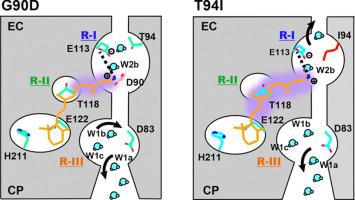Journal of Molecular Biology ( IF 4.7 ) Pub Date : 2020-08-11 , DOI: 10.1016/j.jmb.2020.08.006 Kota Katayama 1 , Yuri Takeyama 2 , Akiko Enomoto 2 , Hiroo Imai 3 , Hideki Kandori 4

|
Rhodopsin is the photosensitive protein, which binds to 11-cis-retinal as its chromophore. In the dark, rhodopsin exists as a stable complex between the opsin moiety and 11-cis-retinal. The absorption of a light photon converts 11-cis-retinal to all-trans-retinal and initiates our vision. As a result, the increase in the rate of dark activation of rhodopsin reduces its photosensitivity resulting in night blindness. The mutations, G90D and T94I are night blindness-causing mutations that exhibit completely different physicochemical characteristics associated with the dark activation of rhodopsin, such as a high rate of thermal isomerization of 11-cis-retinal and a slow pigment regeneration. To elucidate the molecular mechanism by which G90D and T94I mutations affect rhodopsin dark activation and regeneration, we performed light-induced difference FTIR spectroscopy on dark and primary photo-intermediate states of G90D and T94I mutants. The FTIR spectra clearly show that both charged G90D and hydrophobic T94I mutants alter the H-bond network at the Schiff base region of the chromophore, which weakens the electrostatic interaction with Glu113 counterion. Our results further show an altered water-mediated H-bond network around the central transmembrane region of mutant rhodopsin, which is reminiscent of the active Meta-II state. This altered water-mediated H-bond network may cause thermal isomerization of the chromophore and facilitate rhodopsin dark activation.
中文翻译:

视紫红质突变中氢键网络的破坏导致夜盲症。
视紫红质是光敏蛋白,其发色团与11-顺-视网膜结合。在黑暗中,视紫红质作为视蛋白部分和11-顺式-视网膜之间的稳定复合物存在。光子的吸收将11-顺式视网膜转化为全反式视网膜,并启动了我们的视野。结果,视紫红质的黑暗活化速率的增加降低了其光敏性,导致夜盲症。突变G90D和T94I是引起夜盲症的突变,表现出与视紫红质的黑暗活化有关的完全不同的理化特性,例如11-顺式的高热异构化率-视网膜和缓慢的色素再生。为了阐明G90D和T94I突变影响视紫红质黑暗激活和再生的分子机制,我们对G90D和T94I突变体的黑暗和原始光中间状态进行了光诱导的FTIR光谱分析。FTIR光谱清楚地表明,带电的G90D和疏水性T94I突变体都改变了生色团席夫碱区的H键网络,从而削弱了与Glu113抗衡离子的静电相互作用。我们的结果进一步表明,在突变的视紫红质的中央跨膜区域周围,水介导的H键网络发生了变化,这让人联想到活跃的Meta-II状态。这种改变的水介导的H键网络可能引起生色团的热异构化,并促进视紫红质的暗活化。











































 京公网安备 11010802027423号
京公网安备 11010802027423号